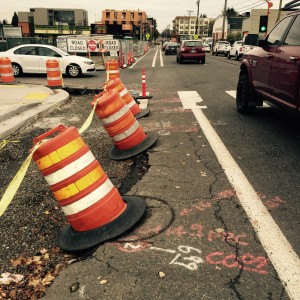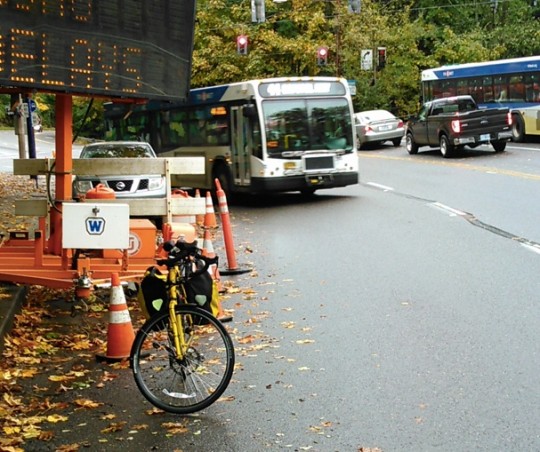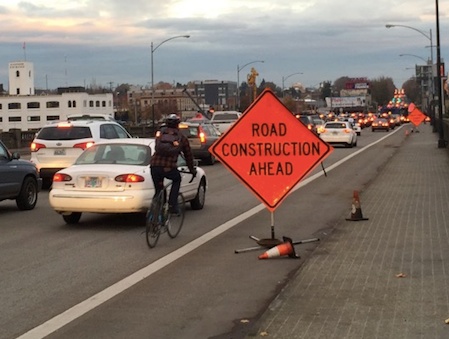The Bicycle Transportation Alliance is fed up with the dangerous work zone conditions on Williams Avenue. Claiming that bicycle riders have been injured and put in danger due to misplaced construction materials and a poorly implemented traffic control plan, the Portland-based non-profit group penned a letter today to the Bureau of Transportation with a laundry list of demands to improve the situation.
While the BTA supports the city’s North Williams Avenue Safety Project and says they are excited to see the finished product, the letter (written by BTA Engagement Manager Carl Larson) points out several specific and ongoing safety concerns — some of which have led directly to injuries.
“We are concerned about high-risk hazards that our office has reported to your bureau,” reads the letter, “We do not believe that they were adequately addressed in a timely manner, and as a result, people have been injured.”
This is not a new problem for PBOT. From the outset of the project over a month ago, people who ride on the road have expressed confusion and concern about how the project is being phased in. After we reported on those concerns, PBOT Director Leah Treat told us via a comment that she too was “experiencing some difficulties.”
Advertisement
There have been a litany of issues with Williams’ bike access ever since the work began. At first it was a lack of signage about how to navigate a bike lane that was moved from left to right. Now that people are accustomed to that change, the big issues have to do with navigated through the street’s many work zones — both from PBOT and private construction firms (there are several major projects along the street).
https://twitter.com/st_toast/status/535857747313451008
Larson, in his letter to PBOT, said that both he and the BTA board chair saw a bicycle rider go down on a new median installed on Williams at Mason. Larson says that a man who crashed on Tuesday suffered a broken collarbone. After Larson reported the issue, PBOT placed one orange cone in front of the new median. “This morning,” Larson wrote in the letter, “The cone had been flattened and the new curb has scrapes across the top of it and chunks taken out of it, presumably the result of getting hit by motor vehicles.”
Larson says PBOT’s response thus far has been to blame contractors and equipment delays while urging the public to be patience.
The larger context with the BTA’s concerns about Williams is that this is far from an isolated issue. On October 20th, after seeing an unacceptable work zone on NW Broadway, we published a story saying that the city needs stronger construction zone standards (or should actually enforce ones already in place). In the weeks since our story we’ve heard of other ongoing hazards on the Burnside Bridge, SW Multnomah Blvd, and elsewhere.
Reader Seth Alford sent us photos of two construction zones in southwest Portland that were completely blocking the bike lane: one on Multnomah and one on Capitol Hwy:
And reader Kyle Rohr sent us photos of signs blocking the bike lanes on the Burnside Bridge:
Beyond Williams and these other recent examples of what seems like a lax approach to work zone bicycle access by PBOT, the BTA has been working on a research project for over a year to examine the city’s approach to construction zones. Back in August, we reported that the BTA was working on a project (headed up by Larson) to find, “ways the city can better design construction zones to work for active transportation.”
The BTA’s letter makes it clear that PBOT is still coming up very short when it comes to keeping road users safe during construction projects.
Here’s the non-profits list of things they want to see PBOT do now:
- Review the traffic control plan with the contractor and agree upon standards for its implementation.
- Review traffic control plans made by developers on Williams and insure that they are appropriate and are being followed.
- Make routine checks of the street after dark (its peak time of usage by people on bikes) to identify and immediately address potential hazards.
- Install physical separation between Weidler and Broadway as soon as possible.
- Prioritize sweeping of leaves in the new Williams bike lane.
- Immediately close the dangerously narrow bike lane on the block approaching Cook and turn the left travel lane into a bike lane.
- Install signage advertising NE Rodney as a bike-friendly alternate route.
Back on November 6th, in light of a dangerous work zone on NW Broadway, I asked PBOT to clarify their approach to traffic management during construction projects. “Our permits process is intended to ensure public safety while also minimizing inconvenience,” PBOT spokesman Dylan Rivera said, “We try to accommodate all users of the right of way as best we can. That includes people driving, bicycling, walking, operating trucks and doing maintenance and construction work in the right of way.”
So far, PBOT hasn’t responded to Larson’s letter about Williams.
—————————
UPDATE, 2:15 pm: Yesterday I emailed Williams Avenue project manager Rich Newlands to get a clarification on the timeline for completing the signage and striping. Here’s his response:
The [construction] contract end is December 15. Because the delivery of signal poles for Cook and Broadway have been significantly delayed, we will be granting additional time to complete that work, but only that part of the overall contract.The amount of additional time has not yet been negotiated. At today’s weekly construction meeting the contractor indicated that he was still on track to substantially complete the non-signal work by the original end date.
Regarding signing and striping, they are very close to having everything in place per the plans. For striping there is some touch up work and the crosswalks at the new curb extensions, which are waiting for the civil work and paving to be completed. Hope to have the forced left-turn signs at mounted on the islands between Beech and Mason the week after next — after the work at Failing is scheduled to be completed. That includes the one missing median, which has not been done yet because the contractor wants to pour the curb extensions at the same time. At Stanton [Dawson Park], we are reviewing options for additional pavement markings, signage, and/or physical barriers to address the compliance problem there with traffic not turning left.
After much delay, the paving around the curb extensions that have been built is finally happening today, so construction choke points, such as the one at Cook will be removed.






